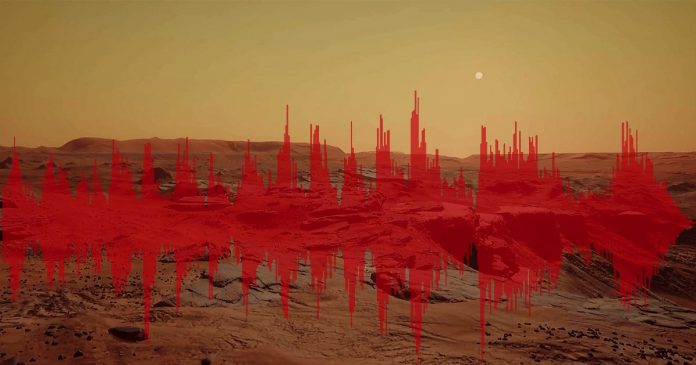This fresh in from the Elysium Planitia of Mars: the sound of wind from an alien world. On its 10th day as a new resident of the red planet, NASA’s InSight lander’s pressure sensor transmitted air vibration data from its trembling solar panels, representing a steady breeze about 99 million miles away. The combination of photos sent back from the craft with the sound of Martian wind gives Earth residents a unique moment to feel like they’ve joined the craft themselves. “It’s fun to imagine that I’m there,” mused Don Banfield during a JPL media teleconference discussing the recording. Banfield is InSight’s Auxiliary Payload Sensor Subsystem (APSS) Science Lead.
InSight, short for “Interior Exploration using Seismic Investigations, Geodesy and Heat Transport”, launched aboard an Atlas V rocket on May 5, 2018 and successfully landed on the Martian surface on November 26, 2018. The craft is a seismic investigator sent to study the red planet’s core, eventually drilling 10-16 feet down into its crust to gather geographical data. The craft’s landing event was live streamed online for viewers around the world, greeting Earthlings with a photo of its new home’s surface shortly after. It sent back more photos of the surrounding area prior to the wind recording.
The thin CO2 atmosphere on Mars doesn’t translate high sounds well, so the recorded vibrations from InSight’s pressure sensor are low on the audio spectrum, under 50 Hz, thus difficult to hear. However, after the frequency was increased by a factor of 100 (raised two octaves), it became possible to hear what sounds like a steady wind blowing across the regolith. Dust devils tracked in the area moving across the Martian surface had motion consistent with the wind recordings, thus confirming what was being heard by InSight’s scientists.
The way InSight picks up and translates sound is similar to how a human ear works: Air pressure vibrates the eardrum, then that vibration pattern is sent through the inner ear bones to the cochlea which has tiny hairs translating the vibrations into electrical signals sent to the brain. InSight’s solar panels are like its eardrums, the spacecraft structure itself like its inner ear, its instruments like its cochlear, and its electronic box translating and transmitting signals is like brain. The “sounds” we hear from Mars are translated data from wind-caused vibrations.
Ironically enough, wind noise is actually not a particularly desired outcome from InSight’s instruments. According to the scientists participating in NASA’s teleconference discussing the event, the inlet for the pressure sensor was specifically designed to minimize any chatter from air movement. Also, the placement of InSight’s seismographic gear will be based on the best area to reduce input from the lander’s interaction with the vibrations it’s recording, i.e., the lander’s movement from seismic events. It should be noted, though, the Martian wind gracing our human ears for the first time is only a taste of what’s to come from InSight’s instruments.
Once the wind and thermal shield (the white dome in the photos) has been lifted from the lander in a few weeks, all of InSight’s instruments will be exposed to the Martian environment for data collection. For now, the lander’s Earth-based team is first focusing on understanding the area the craft is in to pick the best place to set its instruments. After the main mission begins, however, a full study of Mars’ atmosphere will be underway and we could hear, among other natural events, the sounds of exploding meteors.
While wind may be a unique sound to hear on an alien world, it’s not the first time a NASA craft has entertained our ears and imaginations. Electromagnetic vibrations have been recorded all across our solar system, perhaps the most famous of which originated from the Voyager 1 spacecraft launched in 1977. The data collected from the craft’s radio-capturing instruments has been converted into audio files – you can even find a full album’s worth of the sounds on a variety of streaming sites. Some of the recordings are meditation-worthy, others a touch unnerving. We humans have additionally added some recordings of our own to space via Voyager’s famous “golden record”, the sounds of which are also available for listening online.
If you’re craving a full Martian soundtrack, you’ll be happy to know that NASA’s Mars 2020 rover is planned to provide just that. It will have two microphones on board, one of which will record the actual landing of the rover. Combined with telemetry data and surface photographs, Mars is on its way to its own documentary with inputs completely provided “on-location”. Stay tuned!
Listen to the Martian wind yourself below:








